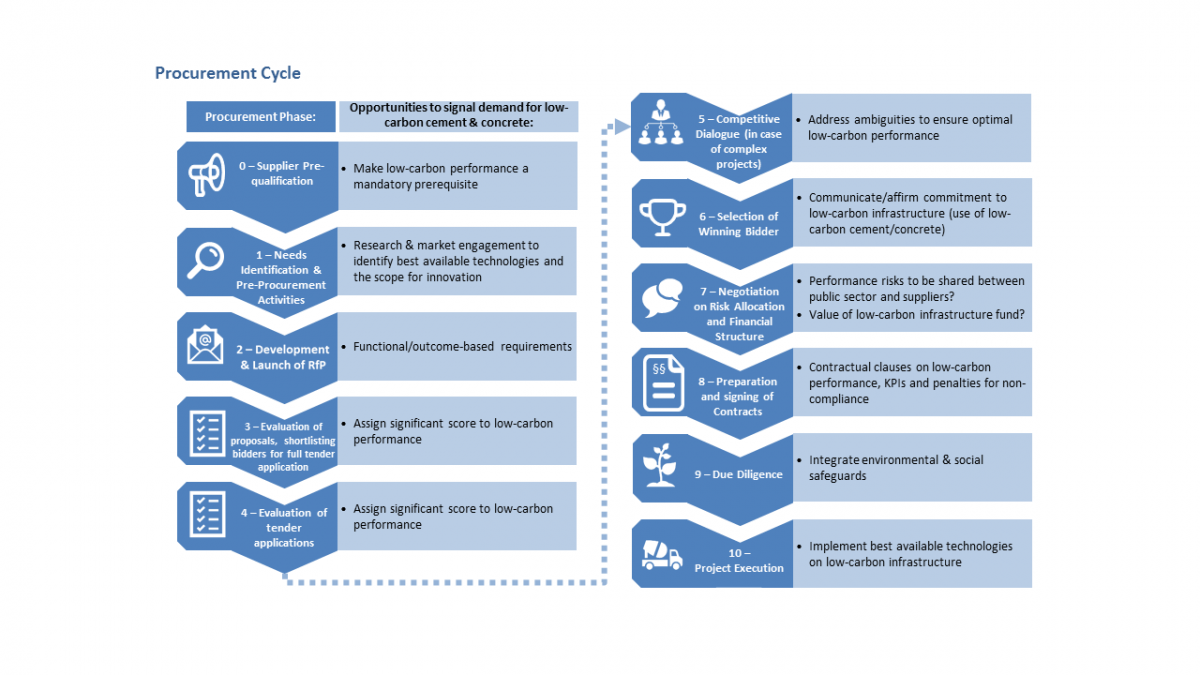Expert Workshop: Public Procurement and Innovation for Low-Carbon Infrastructure
Cement is responsible for 5 per cent of anthropogenic CO2 emissions. IISD will be co-hosting an expert workshop in Brussels on June 23, 2017 that aims to establish effective measures that link public procurement and low-carbon development in the construction industry. We seek to validate our findings and gather further input on strategic recommendations from all relevant stakeholders (industry, public procurers, policy-makers, investors, experts).
Cement is responsible for 5 per cent of anthropogenic CO2 emissions. IISD will be co-hosting an expert workshop in Brussels on June 23, 2017 that aims to establish effective measures that link public procurement and low-carbon development in the construction industry.
We seek to validate our findings and gather further input on strategic recommendations from all relevant stakeholders (industry, public procurers, policy-makers, investors, experts).
Background
The Paris Agreement under the United Nations Framework Convention on Climate Change has set the ambition for global actions to reduce greenhouse gases. As signatories of the Paris Agreement, European governments must start showing the way through a better alignment of their policies with the climate imperative. This also means leading by example in their everyday actions and investments.
The purchasing power of the public purse has the potential to support Europe’s low-carbon industrial development. Today, public procurement of infrastructure in Europe accounts for approximately 22 per cent of the construction sector output, and continuous growth is expected in most infrastructure areas. Given the substantial relevance of cement and concrete for infrastructure projects (combined with the significant emissions of the sector), 1 public procurement constitutes a high-impact policy arena for achieving deep decarbonization and more circular practices in these sectors. It thus can create lead markets in Europe for low-carbon cement and concrete products, as well as for other low-carbon building materials. Although it features as an important element of the European Commission’s Single Market Strategy, public procurement is currently underused as a policy instrument to drive low-carbon innovation.
The International Institute for Sustainable Development (IISD) and the Industrial Innovation for Competitiveness initiative (i24c) are investigating the extent to which (and how) public procurement can drive markets for low-carbon solutions and innovation in Europe, focusing on infrastructure. Our aim is to collect further evidence on strategies and effective public purchasing-related instruments that facilitate infrastructure development with low-carbon and more circular building materials.
Our research
Since January 2017, we have been conducting desk research, participated in several round table events and conducted 15 in-depth semi-structured interviews with industry, national and local procurement agencies and innovation brokers. All interviews conclude that there is clear potential for public procurement to increase low-carbon practices in the infrastructure and construction value chain—and proven examples of how to do so. They also underline that there is no silver bullet. Innovation can be triggered at various stages of the procurement cycle, as illustrated by the figure below. Depending on the project, certain stages of the procurement cycle will be more suitable and powerful than others to drive innovation and circularity in the building materials sector.

During the workshop, we will discuss the procurement cycle in detail and present those steps that are the most important for positioning public procurement as an innovation and low-carbon lever.
Objectives and expected outcome of the workshop
With this expert workshop, we aim to establish effective measures that link public procurement and low-carbon development in the construction industry. We seek to validate our findings and gather further input on strategic recommendations from all relevant stakeholders (industry, public procurers, policy-makers, investors, experts).
Building on the participants’ expertise and diverse perspectives, the workshop will provide space to elaborate on new pathways for public procurement for prioritizing low-carbon cement while ensuring sustainability of final infrastructure assets. We will collectively develop strategic recommendations for policy-makers and procurers on how to identify and reward low-carbon solutions, and hence scale long-term demand, R&D and investments for low-carbon infrastructure.
Expected outcomes:
- Validation of our findings and policy recommendations
- Dialogue on the use of functional/performance-based specifications
- Dialogue on the effectiveness of current EU policies on procurement and innovation
- Concise inputs for instruments and strategies to be applied in public procurement
- Insights about industry needs to accelerate the market introduction of low-carbon material innovations and the role of public authorities, innovation brokers and investors
- Prospects for standardized approaches and/or product standards in public infrastructure projects (without inhibiting innovation and recognizing variety in raw material availability)
- Facilitation of communication and transparency between public sector and the cement and the construction industry
- Dialogue on risk sharing and financing
What is low-carbon infrastructure?
- Assets that are designed, built and operated in a manner that reduces carbon emissions
- Assets that incorporate building materials that have lower embodied carbon
What is low-carbon cement?
- Cements with low clinker content based on using supplementary cementitious materials (e.g., fly ash, slag, pozzolana, limestone)
- Innovative materials, material compositions or processes that reduce the embodied carbon content (e.g., mechanical treatment, lower temperature requirements, utilization of recycled materials)
- High-performance cements with positive carbon impact in subsequent life-cycle stages (e.g., lower amounts of cement for same performance of concrete, carbon absorption properties, improved recyclability)
Preliminary Agenda
This workshop is meant as an exchange among all participants, invited in their personal capacity, and held under the Chatham House Rule.
10:00 | Welcome and registration |
10:30–11:30 | How effective is the EU agenda on procurement and innovation to drive low-carbon infrastructure? Interventions: IISD / EC - DG GROW / WEF Moderation: i24c
|
11:30–12:30 | Innovation in low-carbon building materials Interventions: industry / CEMBUREAU and/or Canadian Cement Association Moderation: i24c
|
12:30–13:15 | Lunch |
13:15–14:00 | Procurement and innovation Interventions: Innovation broker / RWS / City of Amsterdam Moderation: i24c What are the tools and best practices for evaluating tenders from an innovation and sustainability perspective?
|
14:00–15:00 | Risk sharing and finance Interventions: EC DC GROW / Anglian water / Innovation broker / SITRA / Francetech and/or BusinessFrance / OVG Real Estate Moderation: IISD
|
15:00–15:30 | Next steps (IISD & i24c) |
About IISD & its expertise on public procurement and infrastructure finance
IISD is observer to the OECD Leading Practitioners on Public Procurement Working Group, Member of the G20/B20 Finance and Inclusive Growth Task Force, the G20 Sherpa’s advisory group on infrastructure, the Global Environment Facility Technical Advisory Group on Green Infrastructure and Green Finance, and the GGKP Green Growth and the Law Research Committee. IISD is currently undertaking similar research to advise the Government of Canada on public procurement strategies for low-carbon infrastructure. It is also working with the government of the Western Cape Province in South Africa on performance-based procurement to implement their Green Economy Strategy.
About i24c
Launched in June 2015, i24c, the Industrial Innovation for Competitiveness initiative is European Climate Foundation's (ECF’s) platform dedicated to developing and promoting an industrial strategy that secures European industry’s competitive advantage through innovation. The initiative communicates an evidence-based narrative to inform the critical debate on industrial policy. The approach of i24c is twofold; it focuses on the extent to which Europe and member states can define industrial strategies that would turn help Europe into an "Entrepreneurial Union" capable of leading the world and stimulating purposeful innovation to meet “grand challenges." It undertakes holistic value chain analyses to identify innovation and competitiveness potentials along the complete value chain.
I24c’s work is guided by a High-Level Group of leading policy-makers, industrialists and thought leaders. The members of the High-Level Group act as ambassadors of i24c’s work, and provide a platform to test and check the work of the initiative, which takes place three times a year at the i24c High Level Group meetings.
[1] The cement sector’s global emissions account today for approximately 5 per cent of anthropogenic CO2 emissions. Source: European Cement Association(CEMBUREAU). (2013). The role of cement in the 2050 low carbon economy. Retrieved from http://lowcarboneconomy.cembureau.eu/uploads/Modules/MCMedias/1380546575335/cembureau---full-report.pdf
Additional downloads
Upcoming events
Building Bridges: The State of Nature-Based Investments
Join us for a panel at the Building Bridges conference in Geneva, Switzerland, to discuss the state-of-play of nature-based investments and the potential opportunities they present.
Through Her Lens: Women leading change in sustainable agriculture and market inclusion
Despite the critical role that women play in agricultural production, they still do not have equal access to global agricultural supply chains on terms that benefit them.
A Municipal Perspective on the Value of Natural Infrastructure
This webinar will showcase examples the cost-effectiveness of natural infrastructure from a municipal perspective. Focusing on what municipalities need—what evidence and numbers they rely on, and what tools and planning processes are required to ensure that natural infrastructure is assessed alongside traditional infrastructure for cost-effectiveness.
